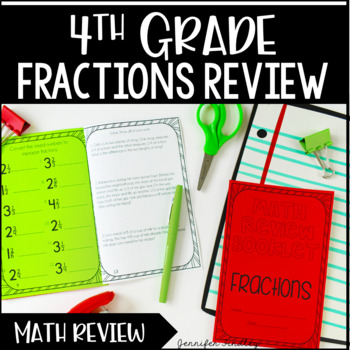4th Grade Fractions
- PDF
What educators are saying
Also included in
- Math review can be made just a bit more interesting just by changing up the format. This resource is a bundle of my math review booklets for 4th and 5th grade.Click here to see my review booklets for reading and language.About the 4th and 5th Grade Math Review BookletsI created these 4th and 5th graPrice $10.00Original Price $19.00Save $9.00
Description
4th Grade Fraction Review at your fingertips!
Need 5th grade fraction review? Click here!
About the 4th Grade Fraction Review Booklet
I created this resource to have a ready made resource for re-teaching and reviewing 4th grade fraction skills. My students respond really well to the novelty of printable mini-booklets. It still gives them that pencil-to-paper practice, but in a less threatening format.
To save copies, there are two students page on one page.
This 4th grade fractions review booklet can be used at the end of a 4th grade fraction unit as review/assessment or at the beginning of a 5th grade fraction unit to pre-assess and re-teach necessary 4th grade fraction skills.
****This resource does not include steps or instructions for the skills. It’s practice only.
This resource includes a practice page for these 4th grade fraction skills:
Naming Fractions (Shaded Area)
Naming Fractions (Unshaded Area)
Labeling Fractions on a Number Line
Identifying Fractions on a Number Line
Drawing Models
Generating Equivalent Fractions
Equivalent Fractions
Simplifying Fractions
Mixed Number to Improper Fraction
Improper Fraction to Mixed Number
Decomposing Fractions
Adding and Subtracting Fractions (Like Denominators)
Fraction Word Problems
Adding and Subtracting Mixed Numbers (Like Denominators)
Subtracting Mixed Numbers (Borrowing from the Whole)
Mixed Number Word Problems
Multiplying Fractions by Whole Numbers
Multiplying Fractions by Whole Numbers Word Problems
Comparing Fractions
Ordering Fractions
Using the 4th Grade Fractions Review Booklet
The possibilities for use of this resources are numerous. Here are some ideas:
Mini Check Ins or Assessments
Test Prep
Re-teaching
Independent Practice
Centers
RTI
Homework
Morning Work
You may also like:
Multiplying and Dividing Fractions Resources
Adding and Subtracting Mixed Numbers Resources
Subtracting Mixed Numbers with Regrouping Resources
Differentiated Fraction Math Tasks






